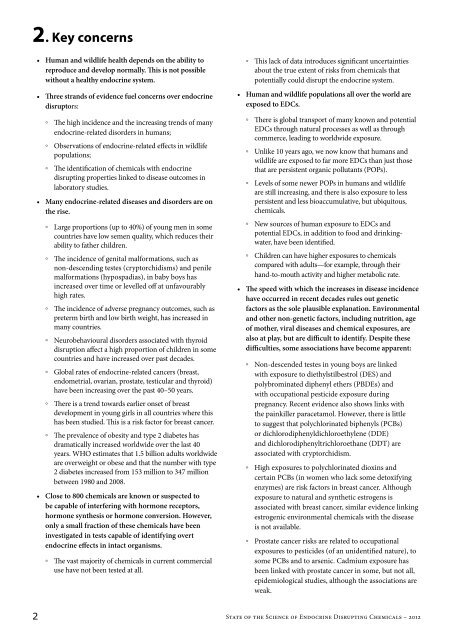Endocrine Disrupting Chemicals 2012 - World Health Organization
Endocrine Disrupting Chemicals 2012 - World Health Organization
Endocrine Disrupting Chemicals 2012 - World Health Organization
You also want an ePaper? Increase the reach of your titles
YUMPU automatically turns print PDFs into web optimized ePapers that Google loves.
2. Key concerns<br />
• Human and wildlife health depends on the ability to<br />
reproduce and develop normally. This is not possible<br />
without a healthy endocrine system.<br />
• Three strands of evidence fuel concerns over endocrine<br />
disruptors:<br />
◦ The high incidence and the increasing trends of many<br />
endocrine-related disorders in humans;<br />
◦ Observations of endocrine-related effects in wildlife<br />
populations;<br />
◦ The identification of chemicals with endocrine<br />
disrupting properties linked to disease outcomes in<br />
laboratory studies.<br />
• Many endocrine-related diseases and disorders are on<br />
the rise.<br />
◦ Large proportions (up to 40%) of young men in some<br />
countries have low semen quality, which reduces their<br />
ability to father children.<br />
◦ The incidence of genital malformations, such as<br />
non-descending testes (cryptorchidisms) and penile<br />
malformations (hypospadias), in baby boys has<br />
increased over time or levelled off at unfavourably<br />
high rates.<br />
◦ The incidence of adverse pregnancy outcomes, such as<br />
preterm birth and low birth weight, has increased in<br />
many countries.<br />
◦ Neurobehavioural disorders associated with thyroid<br />
disruption affect a high proportion of children in some<br />
countries and have increased over past decades.<br />
◦ Global rates of endocrine-related cancers (breast,<br />
endometrial, ovarian, prostate, testicular and thyroid)<br />
have been increasing over the past 40–50 years.<br />
◦ There is a trend towards earlier onset of breast<br />
development in young girls in all countries where this<br />
has been studied. This is a risk factor for breast cancer.<br />
◦ The prevalence of obesity and type 2 diabetes has<br />
dramatically increased worldwide over the last 40<br />
years. WHO estimates that 1.5 billion adults worldwide<br />
are overweight or obese and that the number with type<br />
2 diabetes increased from 153 million to 347 million<br />
between 1980 and 2008.<br />
• Close to 800 chemicals are known or suspected to<br />
be capable of interfering with hormone receptors,<br />
hormone synthesis or hormone conversion. However,<br />
only a small fraction of these chemicals have been<br />
investigated in tests capable of identifying overt<br />
endocrine effects in intact organisms.<br />
◦ The vast majority of chemicals in current commercial<br />
use have not been tested at all.<br />
◦ This lack of data introduces significant uncertainties<br />
about the true extent of risks from chemicals that<br />
potentially could disrupt the endocrine system.<br />
• Human and wildlife populations all over the world are<br />
exposed to EDCs.<br />
◦ There is global transport of many known and potential<br />
EDCs through natural processes as well as through<br />
commerce, leading to worldwide exposure.<br />
◦ Unlike 10 years ago, we now know that humans and<br />
wildlife are exposed to far more EDCs than just those<br />
that are persistent organic pollutants (POPs).<br />
◦ Levels of some newer POPs in humans and wildlife<br />
are still increasing, and there is also exposure to less<br />
persistent and less bioaccumulative, but ubiquitous,<br />
chemicals.<br />
◦ New sources of human exposure to EDCs and<br />
potential EDCs, in addition to food and drinkingwater,<br />
have been identified.<br />
◦ Children can have higher exposures to chemicals<br />
compared with adults—for example, through their<br />
hand-to-mouth activity and higher metabolic rate.<br />
• The speed with which the increases in disease incidence<br />
have occurred in recent decades rules out genetic<br />
factors as the sole plausible explanation. Environmental<br />
and other non-genetic factors, including nutrition, age<br />
of mother, viral diseases and chemical exposures, are<br />
also at play, but are difficult to identify. Despite these<br />
difficulties, some associations have become apparent:<br />
◦ Non-descended testes in young boys are linked<br />
with exposure to diethylstilbestrol (DES) and<br />
polybrominated diphenyl ethers (PBDEs) and<br />
with occupational pesticide exposure during<br />
pregnancy. Recent evidence also shows links with<br />
the painkiller paracetamol. However, there is little<br />
to suggest that polychlorinated biphenyls (PCBs)<br />
or dichlorodiphenyldichloroethylene (DDE)<br />
and dichlorodiphenyltrichloroethane (DDT) are<br />
associated with cryptorchidism.<br />
◦ High exposures to polychlorinated dioxins and<br />
certain PCBs (in women who lack some detoxifying<br />
enzymes) are risk factors in breast cancer. Although<br />
exposure to natural and synthetic estrogens is<br />
associated with breast cancer, similar evidence linking<br />
estrogenic environmental chemicals with the disease<br />
is not available.<br />
◦ Prostate cancer risks are related to occupational<br />
exposures to pesticides (of an unidentified nature), to<br />
some PCBs and to arsenic. Cadmium exposure has<br />
been linked with prostate cancer in some, but not all,<br />
epidemiological studies, although the associations are<br />
weak.<br />
2 State of the Science of <strong>Endocrine</strong> <strong>Disrupting</strong> <strong>Chemicals</strong> – <strong>2012</strong>
















